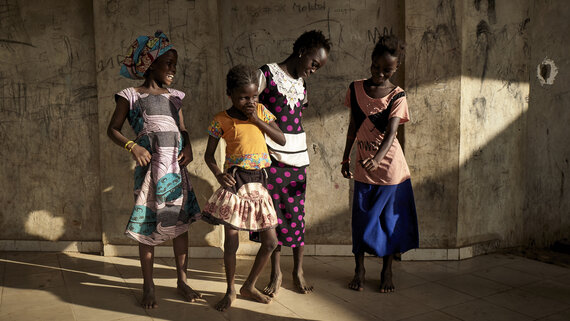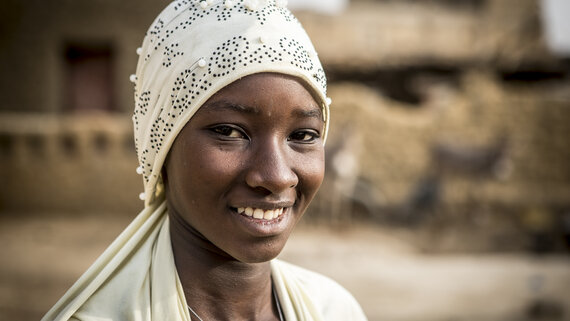Analysis of the context, crisis and needs
In 2021, the humanitarian crisis in Mali worsened due to an increase in and expansion of intercommunal violence and attacks by non-State armed groups (NSAGs) in the central, southern and western regions. The crisis was aggravated by the political upheavals marked by two coups d'état in August 2020 and May 2021, and persistent uncertainty of the political transition leaves the State with weakened capacity to meet people’s basic needs. Over 90 per cent of the rural population live in a conflict area or fear that the conflict will spread to their locality. The use of improvised explosive devices, the destruction of communication antennas, bridges and roads, the encirclement of villages and markets by NSAGs, and counter-insurgency military operations are hindering populations’ access to services and livelihoods and preventing the mobility of personnel and humanitarian commodities.
Internal displacement of people increased by 100,000 in 2021, reaching over 401,000 quadruple the number seen two years ago. A total of 156,000 Malian refugees reside in neighbouring countries while Mali hosts and provides protection and assistance to 48,000 refugees. Mali’s economic gains eroded, with 900,000 people (0.04 per cent of the population) falling back into poverty due to the socioeconomic impacts of COVID-19. Households' weakened capacity to recover is due to income loss, reduced remittances and a higher cost of living. The World Bank forecasts an increased poverty rate of 4.8 per cent in 2022. The protection crisis worsened with an increase in security incidents. Gender-based violence (GBV) actors reported 5,486 GBV incidents, an increase of 41 per cent of cases reported at the same period in 2020. The latest United Nations (UN) report of the UN Secretary-General recorded a 32 per cent increase in human rights incidents compared to 2020.

Gao, Mali
Displaced children dance and have fun at the camp for people who fled violent clashes in central Mali. They arrived at the site at the end of 2018. According to the 2020 census, the site hosts around 600 displaced households.
OCHA/Michele CattaniMore than 1,640 schools are closed due to insecurity, affection more than 2.9 million children, 40 per cent of whom are in four districts of the central Mopti region. In the southern regions, 10 per cent of schools are reported closed in Koulikoro, Koutiala and Sikasso, denying 30,000 children their education. To date, Mali reported over 15,800 COVID-19 cases. In 2021 health-service delivery declined by 22 per cent in comparison to 2020, a decrease of 31 per cent of curative consultations and a decrease of 24 per cent of Penta vaccination coverage. Twenty-one health centres are non-functional and 82 are partially functional due to insecurity. Despite a decrease in the acute malnutrition rate from 9.4 to 7.2 per cent between 2019 and 2020, 2.6 million people will need curative and preventive nutritional assistance in 2022, an increase of 1.5 million people compared to 2021. In 2021, 1.3 million people experienced an elevated level of acute food insecurity, the highest level since 2015, and 3 million people were affected by the poor rains and an extended lean season.
The humanitarian situation remains hampered by increased needs and low funding, with 32 per cent of funds mobilized as of 31 October 2021. Despite operational constraints, humanitarian partners assisted over 2.45 million of 4.7 million targeted people as of 30 September 2021.
Projected situation in 2022 and beyond
2022 forecasts a worsening multidimensional crisis politically, socio-economically and developmentally. Political and institutional reform implementation, as adopted in the 2 August 2020 “Plan d’Action du Gouvernement”, will be delayed. This will hinder the investment required for a return of State authorities and services throughout Mali, resulting in reliance on humanitarian assistance. The risk of sanctions imposed due to political delays is high. The persistence of State absence, rampant impunity and widespread armed violence will continue to generate multiple and protracted displacements, accentuating the civilian population’s vulnerabilities and negative coping mechanisms and increasing the risk of community tensions.

Dialangou, Mali
This girl used to miss out on her education due to water collecting responsibilities. But today, there's a new water pump next to her school. She said: "We're so happy to have the new water pump. We'll have clean drinking water, and our village will be even cleaner. There'll be fewer illnesses and children will go to school in good health." In Dialangou village, whose size recently tripled due to the arrival of internally displaced families, women and girls used to fetch stagnant, unsanitary water from a nearby pond, which caused illness in the village. Other women and children walked to a water point 45 minutes away, which often made children late for school. Girls, who are responsible for fetching water, sometimes missed entire days of school. The new water point not only brings clean water to residents and displaced families in Dialangou but is also improving children's health and helping girls remain in school.
UNICEF/Harandane DickoThe combined shocks will reduce households’ recovery and resilience capacities in severely crisis-affected areas. Exceptionally high cereal prices undermine households’ ability to access sufficient and diversified food. The agricultural harvest of 2021-2022 forecasts a 20-50 per cent drop in crops is observed in the central regions, in the Sahelian strip of Kayes and Koulikoro, Gao, Kidal, Ménaka, Taoudéni and Timbuktu respectively due to floods, water scarcity and abandoned fields as a result of the escalation of violence.
The Humanitarian Response Plan will cover all geographical areas and vulnerable populations including internally displaced persons, returnees, local populations, migrants and refugees. In 2022, of the 12.9 million people affected by the crisis, 6.3 million need humanitarian assistance, which is an increase of 6.8 per cent compared to 5.9 million in 2021.
Response priorities in 2022
In 2022, the Humanitarian community is committed to tackle lifesaving needs of forcibly displaced people, to reduce the burden of food and nutrition crisis, to mitigate the consequences of the widespread absence of state authorities and the worsening protection crisis needs such as GBV and grave violations of child rights.
Mali HRP
To that end four strategic objectives will be the pillars of the humanitarian response:
- To save and preserve the lives and dignity of at least 80 per cent of vulnerable populations affected by humanitarian crisis or natural disasters through multisectoral assistance by end of 2022.
- To enable at least 80 per cent of host populations, IDPs, returnees, migrants and other vulnerable groups in crisis-affected areas of central, northern, southern and western Mali to have access to quality basic social services by end 2022.
- Enable a holistic, cross-cutting, integrated or specialized human rights-based protection approach for at least 80 per cent of affected people across the response, ensuring that protection is at the core of humanitarian action by 2022.
- Build the resilience of at least 80 per cent of people in at least 75 per cent of regions to cope with shocks, reduce vulnerabilities and improve livelihood strategies and disaster preparedness by 2022.
Based on these provisions, partners through an inter sectoral approach will target the most food insecure, health and nutrition, and education involving emergency response to save lives and safeguard livelihoods of the most vulnerable people affected by the conflict, the IDPs, refugees and host communities.
The humanitarian response targeting 4.8 million people requires an overall budget of US$576 million. It takes into consideration the forecasted needs in a worsening situation in the central and southern regions, and a tighter target of 75 per cent of the overall People in Need figure in comparison to 2021.
Further reading
Source: OCHA
Source: Humanitarian Insight
Source: Financial Tracking Service
References
- Mali Multi-sector Needs Assessment, (MSNA), Bamako, September 2021
- Report on populations movement, Mali, Commission movement de populations, September 30th, 2021.
- Data UNHRC portal
- Mali Gender base violence information management system (GBVIMS), report as of August 2021 (UNFPA)
- Report of the UN Secretary General On the situation in Mali, October, 1st 2021
- Mali Cluster Health information management system, Periodic, data update, October 2021
- Mali, Enquete Nationale nutritionnelle anthropométrique et de mortalité retrospective (SMART), (Standardized Monitoring and Assessment of Relief and Transitions),SMART Survey, Mali, Octobre 2021



